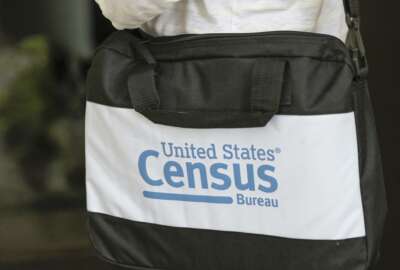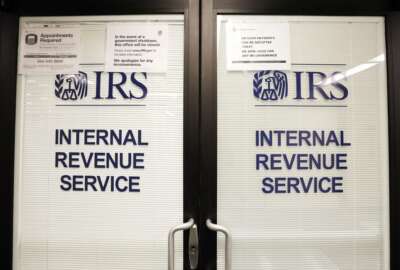
Congressmen wonder why VA Secretary taking so many trips to battleground states
In today's Federal Newscast, top Democrats on the House and Senate VA Committees say Secretary Robert Wilkie is using government time and taxpayer money to take...
To listen to the Federal Newscast on your phone or mobile device, subscribe in PodcastOne or Apple Podcasts. The best listening experience on desktop can be found using Chrome, Firefox or Safari.
- Top Democrats on the House and Senate Veterans Affairs Committees say Secretary Robert Wilkie is using government time and taxpayer money to take politically motivated trips to states key to the upcoming presidential and Senate races. Sen. Jon Tester (D-Mont.) and Rep. Mark Takano (D-Calif.) say Wilkie is prioritizing trips to states like North Carolina and Maine. They want VA to detail all official travel from Wilkie and his senior staff. A VA spokeswoman dismissed the concerns and called them absurd and partisan.
- Federal retirees can expect a 1.3% percent cost-of-living adjustment next year. It’s the lowest COLA for retirees in the last four years. Social Security recipients got a 2% cost-of-living raise last year. The 2021 COLA amounts to a $20 increase in monthly benefits for the average retiree. The Social Security Administration uses the Consumer Price Index for wage earners under the age of 60 to set COLAs each year. But the National Active and Retired Federal Employees Association said the COLA fails to keep up with inflation and rising health care costs for seniors.
- The Office of Personnel Management is planning to add a job status indicator on USAJOBS.gov some time next year. The Government Accountability Office said the tracker will show how many people have applied to a position and will notify applicants when the job is filled. GAO evaluated USAJOBS and measured recent OPM updates against government web usability standards. GAO says OPM listened to user feedback and made some positive updates to the site in recent years. The search function and keyword filters are working better now after some recent updates. OPM also simplified its job announcement templates.
- The Census Bureau can wrap up field operations for the 2020 population count early following a Supreme Court ruling. The court’s ruling overturned a federal court judge’s order earlier this month that would have kept the bureau knocking on doors through the end of October. The Trump administration argued the bureau needs to end field operations now so it can submit apportionment data before the end of December. Justice Sonia Sotomayor in her dissent said the court ruling sacrifices accuracy for speed. (Federal News Network)
- Maybe there is hope for the U.S. Postal Service. Young people aren’t totally digital. The USPS Office of Inspector General recently surveyed members of Generation Z, those between eight and 23 years old. They might be digital natives, but they like the emotional connection of mail, greeting cards, thank-you notes, packages of all sorts. The IG recommends reviving programs to kindle that interest in mail. It suggested a passport program similar to that of the National Park Service, to collect stamps and coins by visiting post offices.
- The IRS is working on a strategy to decommission legacy IT systems. These plans are coming into focus well ahead of any actual plans to unplug any machines. The strategy is taking shape in concert with the work of the Enterprise Case Management and Digitalization Office the agency stood up in July. All of this work is taking place under a six-year IT modernization strategy the IRS launched last year. IRS officials say this plan will succeed where others fell short because the business side of the agency is taking a bigger role in the day-to-day work. (Federal News Network)
- The Defense Department entered into a nearly half billion dollar agreement with Cue Health to develop 100,000 COVID-19 tests per day by March 2021. The award will increase government capacity to deliver 6 million coronavirus tests in a day. The tests are of the nasal swab variety and detect the virus in about 20 minutes. DoD entered into the agreement through an other transaction authority. Those awards allow the Pentagon to skirt around Federal Acquisition Regulations to more rapidly deliver a product.
- After a delay caused by the coronavirus pandemic, the National Museum of the U.S. Army plans to open its doors on Veterans Day. The new facility at Fort Belvoir, Virginia, had planned to open in June, but some of the finishing touches had to be delayed because of COVID-19. The 185,000 square foot facility aims to tell the Army’s entire 240-year history. Although it’s located on Army real estate, it’ll be accessible to the public, without admission charges. The project is a joint venture between the Army and the nonprofit Army Historical Foundation.
- The Army is preparing for the next phase in its human resources update. The Integrated Personnel and Pay System – Army will be available to active duty soldiers in December 2021. The new HR system allows troops to upload talents, skills and other attributes that might make them more valuable to a command. Likewise, commanders will be able to search for soldiers who fit the profile they need. The Army will add new features every year and finalize the program in May 2025 by moving all payroll systems over. The Army says it is conducting live training on the new HR program and posting that training to social media.
- The Trump administration wants the departments of Homeland Security and Justice to turn up the heat on e-commerce platforms who sell counterfeit products. President Donald Trump signed a memo telling DHS and DoJ to focus their enforcement efforts on seizing counterfeit goods that move through these e-commerce sites and fining the parent companies. Within 120 days, DoJ and DHS should develop a legislative proposal to clarify and strengthen their authority and increase their resources to deter and address counterfeit trafficking.
- A new approach to sharing cyber threat information may be coming to defense contractors. The Department of Defense Cyber Crime Center and the Defense Counterintelligence and Security Agency are recommending creating a new vulnerability disclosure program with defense contractors. The two DoD organizations issued a white paper detailing their research and how the cybersecurity threat sharing program could work. DC3 and DCSA say the pilot should be limited to 20 defense contractors, with each organization managing 10. The goal of the VDP is for cyber researchers to analyze the contractor’s network looking for vulnerabilities and then report those problems to a central database where all participants benefit from the discovery.
Copyright © 2025 Federal News Network. All rights reserved. This website is not intended for users located within the European Economic Area.
Eric White
Eric White is news anchor and Federal Drive producer at Federal News Network.
Follow @FEDERALNEWSCAST
Related Stories
(AP Photo/John Raoux)

Supreme Court halts census in latest twist of 2020 count




